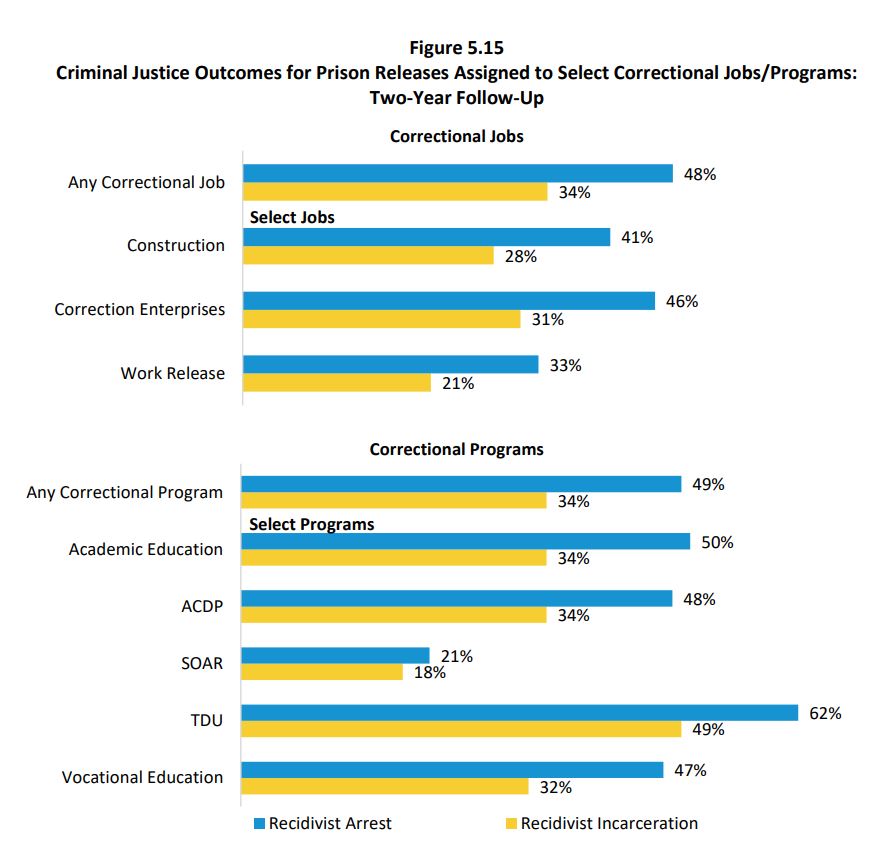The North Carolina Sentencing and Policy Advisory Commission released its biennial Correctional Program Evaluation, better known as the Recidivism Report. It is prepared in conjunction with the Division of Adult Correction and Juvenile Justice of the North Carolina Department of Public Safety, as required by G.S. 164-47. The full report is available here. It covers defendants placed on probation or released from prison in Fiscal Year 2019, and examines their subsequent arrests, convictions, and incarcerations during a two-year follow-up period.
Overall recidivism rates. Of the 47,000 people covered by the report, 41 percent were arrested within two years. Probationers (37 percent) were less likely to be re-arrested than prisoners (49 percent). The recidivist incarceration rate for inmates released from prison was 36 percent. Overall rates were down from previous years, with some of that reduction perhaps attributable to the slow-down in court operations as a result of COVID-19. See Recidivism Report at 125 (“Noticeable reductions in all three measures of recidivism for the current sample were observed when compared to the FY 2017 sample – 41% compared to 44% for recidivist arrests, 16% compared to 21% for recidivist convictions, and 21% compared to 23% for recidivist incarcerations, respectively.”)
Risk assessments. As you may know, the DACJJ performs a risk-needs assessment on all probationers and prisoners. (I talked about Probation’s risk assessment process here.) The assessment for probationers places offenders in five “supervision level” categories, from Level 1 (most restrictive) to Level 5 (least restrictive). The recidivism rates for probationers in the different categories played out as expected: Level 1 offenders were the most likely to violate (88 percent), while Level 5 offenders were the least likely to violate (39 percent). That’s reassuring, and helps build faith in the predictive power of the assessment. Things were less clear on the prison release side: multivariate analyses showed that risk level was not a significant predictor of recidivism.
Program-specific results. Court officials often ask what programs, if any, they can recommend to help promote a defendant’s future success. The Recidivism Report offers a bit of insight.
As you can see, the report shows that inmates who participate in work release are rearrested and reincarcerated at a rate lower than inmates as a whole, and lower than those who participate in most other in-prison jobs and programs. By contrast, inmates who participated in Therapeutic Diversion Units (TDUs), defined as “designated and secured housing unit[s] staffed by behavioral health, nursing, custody, and additional ancillary staff . . . designed to decrease the population of offenders with mental illness in restrictive housing and to prepare offenders for successful transitions to less restrictive environments within the prison system and the community at large,” had higher recidivism rates in this report, although a different study showed more promising effects within prison.
As with previous study cohorts, inmates who participate in the Sex Offender Accountability and Responsibility (SOAR) Program at Harnett Correctional Institution have a lower recidivism rate than other program participants. That runs contrary to the conventional wisdom that sex offenders have inescapably high recidivism rates, but it turns out that sex offender recidivism (and the effect of treatment on sex offender recidivism) is a complicated topic. Rates vary among different subcategories of sex offenders, depending on things like the nature of the offense and the sex and age of the victim. At the same time, remember the “universal agreement in the scientific community that the observed recidivism rates of sex offenders are underestimates of actual reoffending.” See Roger Przybylski, Recidivism of Adult Sexual Offenders (July 2015).
Those are just some of the highlights. The full report is definitely worth a closer look. Thank you to the Sentencing Commission staff for its excellent work.
